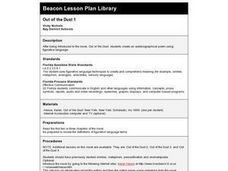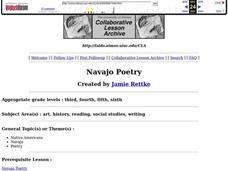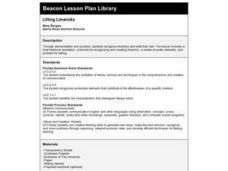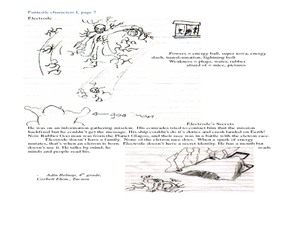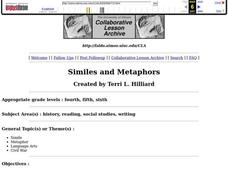Curated OER
Superb Sonnets
Young scholars identify and compare the characteristics of both Italian and English sonnets. They read examples of each, then write an original sonnet in either the Italian or English style.
Curated OER
Out of the Dust 1
Pupils review figurative languages terms and examples. They read the first entry in the book, Out of the Dust, and discuss the images created by the author. Then they create an autobiographical poem using figurative language.
Curated OER
Troubadours
Students perform an original piece in the style of a Medieval troubadour. In this troubadour lesson, students discuss the role of the troubadour and identify facts from a story that a troubadour might share. Students listen to an...
Curated OER
Up From the Streets: Hip Hop as a Recognized Art
Students discuss the historical roots of Hip-Hop to the present as an example of an art form that arose from the street into popular culture. Emphasis is placed on in-class discussion and written reflections in this introductory lesson.
App State
Brainstorming
Get your young writers outside of the traditional essay writing mode with Free Write Friday. Free Write Friday encourages your class to use personal experiences or knowledge to write more creative pieces. Young writers could experiment...
Curated OER
Introducing Communication Talent with "Casey at the Bat"
Analyze the poem "Casey at the Bat." Your team of analysts will read the poem and complete a variety of activities, including describing how Casey looks and acts, describing how he feels before and after he strikes out, and sharing...
Curated OER
Food and Dialect
The dialect words for types of food from across the British Isles get pupils thinking about native dialects and how they differ from Standard English. Class members create a dialect dictionary and discuss the difference between accent...
Lesson Planet
New Books for Black History Month
Suggested books to help students better understand African American history.
Curated OER
Weather and Dialect
What's the difference between an accent and a dialect? Examine the difference between the two with your scholars. In groups, they compile a dialect dictionary. They interview adults to gather information about accents and ethnic words....
Curated OER
Gallery Walk Questions on Earth's Radiation Balance
Questions that can be used in a instructional activity on Earth's radiation balance are suggested in this resource. It is not a lesson plan, per se, but it is a list of questions for stations within a "Gallery Walk" instructional...
Curated OER
I've Just Seen a Face: Portraits
Students examine portraits for different images they project, cite three purposes a portrait can serve, analyze portraits of historical figures, and relate biographical research to portraits.
Curated OER
William Shakespeare's Julius Caesar: Fate versus Free Will
Tenth graders explore Shakespeare's Julius Caesar. After reading specific scenes, they brainstorm and discuss free will. Students observe a clip from the Dr. Phil television show entitled, "Afraid to Age" and make connections from the...
Curated OER
Navajo Poetry
Learners listen to Navajo poetry and create various responses to what they have heard. Students may create an illustration for the poems, create an original work of poetry, or write about how the poem relates to Native American culture.
Curated OER
POETRY AND ME
A visual arts lesson plan combined with language arts, where the students will create a visual poem using crayons. Students are asked to make a connection to an important aspect or event their lives.
Curated OER
Honey Bee Language Arts And Literature
Students see how nature and honey bees are presented in literature. They find and read poetry that include references to bees. Have them write their own poetry or Haiku.
Curated OER
Lilting Limericks
Young scholars discover the formula for writing limericks and use it to write their own poems.
Curated OER
Cinquain
Learners use poetry Cinquain to help review nouns, adjectives, verbs, and synonyms. They follow up by composing their own Cinquain.
Curated OER
What's In A Name
Second graders read Chrysanthemum by Kevin Henkes. They then discuss where various names come from. They create a individualized biopoem and publish it on word processing software. Their poems are compiled into a class book and presented...
Curated OER
Sonnet Form
Pupils explore the sonnet form. In this lesson on sonnet form, students explore various sonnets and how a sonnet can range from conventional to experimental.
Curated OER
The Odyssey: A Deeper Appreciation
Students read "The Odyssey" and identify the ways it relates to their own lives. As a class, they also examine the history of the story and identify the various Greek gods and goddesses. In groups, they focus on the geography of the...
Curated OER
A Selection of Mexican Art
Seventh graders participate in a supplemental activity designed for McDougal Littell's Text "The Language of Literature". They view Mexican artwork by Frida Kahlo and Diego Rivera and complete an art viewing guide. Afterwards, they write...
Curated OER
Research Paper on Orators
Twelfth graders identify the difference between a primary and a secondary source, and use writing as a tool for learning and research. They compile information from primary and secondary sources using available technology.
Curated OER
fantastic Characters
Students study stories. In this writing lesson plan, students discuss the three aspects of a story, read stories focusing on the characters, write a story as a class about a character made up by the class, and write a story with an...
Curated OER
Similes and Metaphors
Use the Civil War and important figures from that period to help your class write poetry. You'll need to create a list of similes and metaphors, but you could also consider having your learners create this the day prior. They will use...



